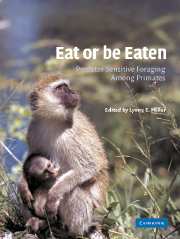Book contents
- Frontmatter
- Contents
- List of contributors
- Preface
- 1 An introduction to predator sensitive foraging
- PART I BIOLOGICAL VARIABLES
- PART II SOCIAL VARIABLES
- 6 The role of group size in predator sensitive foraging decisions for wedge-capped capuchin monkeys (Cebus olivaceus)
- 7 Group size effects on predation sensitive foraging in wild ring-tailed lemurs (Lemur catta)
- 8 Species differences in feeding in Milne Edward's sifakas (Propithecus diadema edwardsi), rufus lemurs (Eulemur fulvus rufus), and red-bellied lemurs (Eulemur rubiventer) in southern Madagascar: Implications for predator avoidance
- 9 Evidence of predator sensitive foraging and traveling in single- and mixed-species tamarin troops
- 10 Predator (in)sensitive foraging in sympatric female vervets (Cercopithecus aethiops) and patas monkeys (Erythrocebus patas): A test of ecological models of group dispersion
- 11 Predation risk and antipredator adaptations in whitefaced sakis, Pithecia pithecia
- PART III ENVIRONMENTAL VARIABLES
- Index
6 - The role of group size in predator sensitive foraging decisions for wedge-capped capuchin monkeys (Cebus olivaceus)
Published online by Cambridge University Press: 10 November 2009
- Frontmatter
- Contents
- List of contributors
- Preface
- 1 An introduction to predator sensitive foraging
- PART I BIOLOGICAL VARIABLES
- PART II SOCIAL VARIABLES
- 6 The role of group size in predator sensitive foraging decisions for wedge-capped capuchin monkeys (Cebus olivaceus)
- 7 Group size effects on predation sensitive foraging in wild ring-tailed lemurs (Lemur catta)
- 8 Species differences in feeding in Milne Edward's sifakas (Propithecus diadema edwardsi), rufus lemurs (Eulemur fulvus rufus), and red-bellied lemurs (Eulemur rubiventer) in southern Madagascar: Implications for predator avoidance
- 9 Evidence of predator sensitive foraging and traveling in single- and mixed-species tamarin troops
- 10 Predator (in)sensitive foraging in sympatric female vervets (Cercopithecus aethiops) and patas monkeys (Erythrocebus patas): A test of ecological models of group dispersion
- 11 Predation risk and antipredator adaptations in whitefaced sakis, Pithecia pithecia
- PART III ENVIRONMENTAL VARIABLES
- Index
Summary
Introduction
Primatologists have only recently begun to investigate the impact of predation on foraging strategies, and the many variables that might mediate this relationship. Traditionally, success in foraging and success in avoiding predators were treated as two independent phenomena. Both might depend upon group size, but the interaction was rarely considered (e.g., for capuchins, Miller 1992, de Ruiter 1986, Srikosamatara 1987). This study explores the extent to which group size influences perceived risk of predation and how this, in turn, affects food intake. Data come from an ongoing study of one population of wedge-capped capuchins (Cebus olivaceus), living at the Hato Piñero Biological Reserve in central Venezuela.
Previous studies with this population of capuchins revealed a strong link between group size and seasonality in food intake. Adult females living in larger groups maintain an essentially constant level of food intake throughout the year (approximately 1800 cm3 of food per female per day, on average). In contrast, those in smaller groups experience dramatic annual variation, consuming very little during the dry season (approx. 1100 cm3) but much more in the wet season (approx. 2900 cm3) (Miller 1996). This pattern is only partly the result of differences in foraging effort. During the wet season, small-group females devote significantly more time to feeding and foraging than do large-group females (68% and 55%, respectively, of their daily activity budgets) and so the disparity in food intake is predictable. However, during the dry season, foraging time is not significantly different (58% in larger groups and 54% in smaller groups) (Miller 1996).
- Type
- Chapter
- Information
- Eat or be EatenPredator Sensitive Foraging Among Primates, pp. 95 - 106Publisher: Cambridge University PressPrint publication year: 2002
- 6
- Cited by



